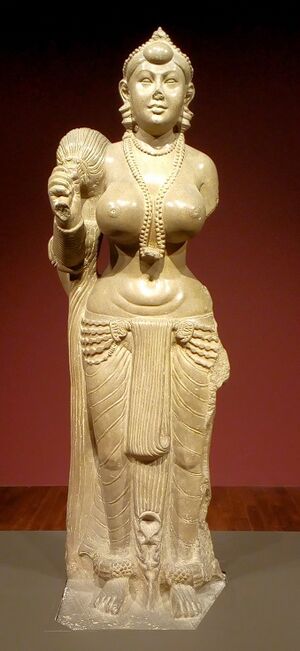Didarganj
| Author:Laxman Burdak, IFS (R) |

Didarganj (दीदारगंज) is a city in the Patna district of Bihar, India. Deedarganj, PIN: 800008
Origin
Variants
- Didaraganja (दीदारगंज) (जिला पटना, बिहार) (AS, p.438)
- Deedarganj
- Didarganj Yakshi
History
Didarganj Yakshi
The Didarganj Yakshi (or Didarganj Chauri Bearer; Hindi: दीदारगंज यक्षी) is sometimes considered as one of the finest examples of Mauryan art in the 3rd century BCE.[1] Alternatively, it is rather dated to the 2nd century CE, based on the analysis of shape and ornamentation.[2][3][4] The treatment of the forelock in particular is said to be characteristically Kushan.[5]
The sculpture is currently located in the Bihar Museum in Bihar, India.[6] It is 64" tall, carved out of a single piece of stone.[7] This life-size standing image is tall, well-proportioned, free-standing sculpture is made of sandstone with well polished surface, a characteristic usually associated with Mauryan polish. The Flywhisk (chauri) is held in the right hand whereas the left hand is broken. The lower garment create a somewhat transparent effect. The Didarganj Yakshi is estimated to date from ca. 3rd century BCE to the 2nd century CE.[8][9] It was excavated on the banks of the Ganges River, at the hamlet of Didarganj Kadam Rasual, northeast of the Qadam-i-Rasul Mosque in Patna City, on October 18, 1917 by the villagers and by the noted archaeologist and historian, Professor J N Samaddar[10] Professor Samaddar, with the help of the then president of Patna Museum Committee and member of Board of Revenue, Mr. E. H. C. Walsh and Dr. D. B. Spooner, the noted archaeologist, retrieved the figure in Patna Museum, Patna.
दीदारगंज यक्षिणी
विजयेन्द्र कुमार माथुर[11] ने लेख किया है ...दीदारगंज (AS, p.438) एक ऐतिहासिक स्थान जो बिहार प्रांत की राजधानी पटना के पास स्थित है। दीदारगंज से 1917 में एक यक्षिणी की सुन्दर मूर्ति प्राप्त हुई। वह मूर्ति अपने हाथ में चमर धारण की हुई है। अतः इसे चामरग्राही यक्षिणी कहा गया है। विद्वानों के मत में यह मूर्ति मौर्यकालीन है। मूर्ति की रचना बहुत ही सुन्दर तथा इसकी मुद्रा अतीव स्वाभाविक है। मूर्ति में शरीर के अंग-प्रत्यंग का अंकन अत्यंत सजीवता के साथ किया गया है। मूर्ति का ऊपरी भाग वस्त्र रहित है तथा अधो भाग में वह साड़ी पहने है। मूर्ति का एक हाथ खंडित है तथा दूसरे में चमर धारण किए हुए है। मूर्ति गले में मुक्तामाल शोभायमान है, जो पुष्ट वक्ष के ऊपर लहराती हुई लटक रही है। क्षीण कटि तथा स्थूल नितम्बों की गुरुता का अंकन भी विदग्धतापूर्ण है। सम्प्रति यह मूर्ति पटना के संग्रहालय में सुरक्षित है।
External links
References
- ↑ Chaudhary, Pranava K (28 September 2006). "A fortress chockfull of chinks". Indiatimes.
- ↑ "A History of Ancient and Early Medieval India: From the Stone Age to the 12th Century" by Upinder Singh, Pearson Education India, 2008,p.364
- ↑ ""Ayodhya, Archaeology After Demolition: A Critique of the "new" and "fresh" Discoveries", by Dhaneshwar Mandal, Orient Blackswan, 2003, p.46
- ↑ "A Companion to Asian Art and Architecture" by Deborah S. Hutton, John Wiley & Sons, 2015, p.435
- ↑ "A Companion to Asian Art and Architecture" by Deborah S. Hutton, John Wiley & Sons, 2015, p.435
- ↑ "This museum in Bihar houses a 2300-year-old sculpture carved out of a single stone".
- ↑ Bengal Archeology website, "Didarganj Yakshi" (7 March 2009)
- ↑ Huntington, John C. and Susan L., The Huntington Archive - Ohio State University
- ↑ "A History of Ancient and Early Medieval India: From the Stone Age to the 12th Century" by Upinder Singh, Pearson Education India, 2008
- ↑ Davis, Richard H. (1997). Lives of Indian Images. New Jersey: Princeton University Press.
- ↑ Aitihasik Sthanavali by Vijayendra Kumar Mathur, p.438

